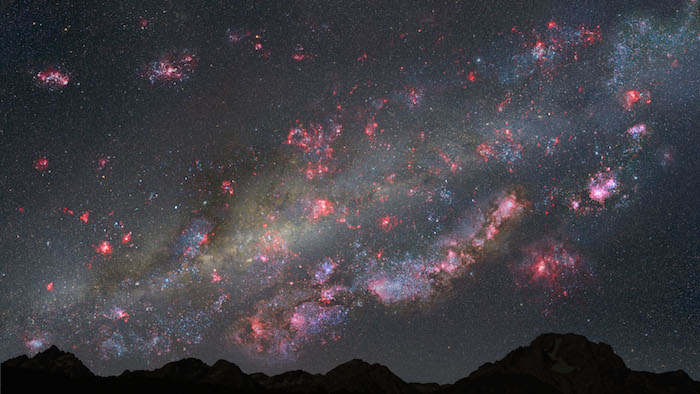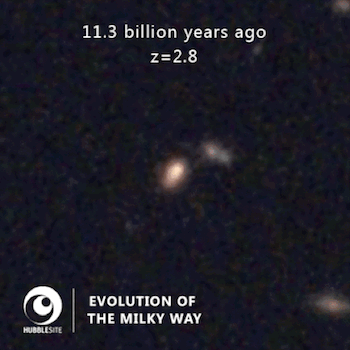.

This illustration depicts a view of the night sky from a hypothetical planet within the youthful Milky Way galaxy 10 billion years ago. The heavens are ablaze with a firestorm of star birth. Glowing pink clouds of hydrogen gas harbor countless newborn stars, and the bluish-white hue of young star clusters litter the landscape. The star-birth rate is 30 times higher than it is in the Milky Way today. Our Sun, however, is not among these fledgling stars. The Sun will not be born for another 5 billion years. (Credit: NASA, ESA and Z. Levay / STScI.)
.
"Most stars today exist in galaxies like the Milky Way, so by studying how galaxies like our own formed, we've come to understand the most typical locations of stars in the universe. We now have the best picture of how galaxies like our own formed their stars."
Casey Papovich, Texas A&M astronomer
.
Picture, if you will, the ultimate universal home movie if not parental keepsake and life story: our Milky Way Galaxy, starting out as but a wee collection of young stars some 12 billion years ago, continuously feeding on the gas of smaller nearby galaxies and undergoing a huge burst of star births to grow increasingly more massive, only to later fade out into the rather tame, large spiral galaxy we've come to inhabit today.
Despite many 21st century advances, from technology to social media apps, such a movie cannot be made. However, thanks to one of the most comprehensive multi-observatory galaxy surveys to date led by Texas A&M University's Casey Papovich, astronomers have come up with the next best thing -- the evolution of the Milky Way in pictures, pieced together using data from NASA and European Space Agency space telescopes and ground-based telescopes as well as thousands of snapshots of galaxies similar in mass to the Milky Way.
"As we look at distant galaxies, we see how they looked when their light left for Earth," said Papovich, lead author on the international team's science paper, which is published today in the April 10 issue of The Astrophysical Journal. "Because the galaxies are billions of light-years distant, we can see how they looked billions of years in the past."
Papovich, along with Texas A&M postdoctoral researchers Vithal Tilvi and Ryan Quadri and roughly two dozen astronomers around the world, spent a year studying carefully selected distant galaxies similar in mass to the progenitor of our own Milky Way that were found in two deep-sky program surveys of the universe, the Cosmic Assembly Near-infrared Deep Extragalactic Legacy Survey (CANDELS) and the FourStar Galaxy Evolution Survey (ZFOURGE). First, the group looked at the more than 24,000 galaxies included in the combined catalog to identify representative galaxies that evolved as our Milky Way did. Then, they made a sequence of how those galaxies grew over time to represent how our own galaxy would have evolved, in effect creating a "movie" of the Milky Way's life from youth to middle age.
"Most stars today exist in galaxies like the Milky Way, so by studying how galaxies like our own formed, we've come to understand the most typical locations of stars in the universe," said Papovich, an associate professor in the Department of Physics and Astronomy and a member of the George P. and Cynthia Woods Mitchell Institute for Fundamental Physics and Astronomy since 2008. "We now have the best picture of how galaxies like our own formed their stars."
Papovich says the team's data clearly illustrates that the Milky Way experienced its most rapid phase of growth between 9.2 and 10 billion years ago, churning out new stars at a spectacular rate that was about 30 times what it is today -- one per year, compared to about 30 each year 9.5 billion years ago. Not surprisingly, it also reveals a strong correlation between star formation and growth in galaxy size, suggesting that the Milky Way itself is responsible for its own star-generating, and therefore, staying power.
"When we calculate the star-formation rate of a Milky Way-like galaxy in the past and add up all the stars it would have produced, we find the mass growth we expected," Papovich said. "We also know that most of these stars formed inside the Milky Way, rather than in other smaller galaxies that later merged with our own. The whole picture hangs together."
Papovich notes that the Sun is among those more recently formed stars, born roughly 5 billion years ago at a point when star formation within the Milky Way had slowed to a comparatively cosmic crawl that continues today. The Sun's somewhat fashionably late appearance actually may have been fortuitous, fostering the growth of the planets within our solar system.
The team's multi-wavelength study, supported by funding from both NASA and the National Science Foundation, spans ultraviolet to far-infrared light, combining observations from NASA's Hubble and Spitzer Space Telescopes, the European Space Agency's Herschel Space Observatory, and ground-based telescopes, including the Magellan Baade Telescope at the Las Campanas Observatory in Chile. The Hubble images from the CANDELS survey also provided structural information about galaxy sizes and how they evolved. Far-infrared light observations from Spitzer and Herschel helped the astronomers trace the star-formation rate.
The international ZFOURGE collaboration is comprised of several universities, including Leiden University in Holland, Swinburne and Macquarie in Australia, Carnegie Observatories in Pasadena, Calif. and Texas A&M, which currently hosts the survey's website and data.
.

This composite of Hubble Space Telescope images illustrates the evolution of Milky Way-like galaxies, as detailed in the most comprehensive, multi-observatory galaxy survey to date, led by Texas A&M University astronomer Casey Papovich. The six chronological images (beginning at far right) reveal that these galaxies -- each similar in mass to our Milky Way -- grow larger and rounder over time. As their stellar population ages, their colors change from blue to yellow to red as their collection of stars burns out in order of brightness. The images were taken between 2010 and 2012 with Hubble's Wide Field Camera 3 and Advanced Camera for Surveys as part of the Cosmic Assembly Near-infrared Deep Extragalactic Legacy Survey (CANDELS). (Credit: NASA, ESA, C. Papovich / Texas A&M University, H. Ferguson / STScI, S. Faber / University of California, Santa Cruz and I. Labbe / Leiden University.)
.

An animated version of the Milky Way Galaxy's life story.
.
Quelle: Texas A&M University
4255 Views
